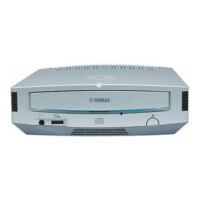
Do you have a question about the Yamaha CD Recordable/Rewritable Drive CRW-F1UX and is the answer not in the manual?
| Brand | Yamaha |
|---|---|
| Model | CD Recordable/Rewritable Drive CRW-F1UX |
| Category | CD/CDR Drive |
| Language | English |
Details the compliance statement and declaration of conformity procedures for the device.
Specifies laser class, wavelength, pulse durations, and output power.
Essential safety measures to avoid electrical shock, damage, fire, or serious injury.
Basic precautions to avoid physical injury, device damage, or property damage.
Guidelines for safely transporting the device, including disc removal and packaging.
High quality audio writing mode for creating superior sounding CDs.
Enables burning text or pictures onto the data surface of a CD-R disc.
Details the drive's writing and reading speeds up to 44X for CD-R.
Enhanced stability writing technology using an 8MB buffer for reliable disc writing.
New standard for packet writing, offering background formatting and disc ejection.
High-speed data transfer capability and hot-plug support via USB 2.0.
Identifies and describes the function of parts on the front of the drive.
Details the ports and switches located on the rear of the drive.
Guidelines for handling discs to prevent errors, damage, or malfunction.
Information on copyright duplication and Yamaha's liability limitations.
Lists compatible disc types, shapes, and writing speeds for CD-R discs.
Details compatibility and writing speeds for CD-RW and High Speed CD-RW discs.
Specifies compatibility and writing speeds for Ultra Speed CD-RW discs.
Lists CPU, RAM, OS, and storage space required for the drive's operation.
Details USB 2.0 port requirements and connection via USB 1.1.
Information on USB cable length, supported operating systems, and CD writing software.
Instructions on locating and recording the drive's serial number for support.
Initial steps for connecting the drive, including powering off and checking the switch.
Details on connecting the USB cable and the AC adapter to the drive.
Instructions for connecting the power cable to the AC adapter and wall socket.
Turning on the drive and connecting the USB cable to the computer's USB port.
Steps for installing device drivers for different Windows versions.
Verifying that the drive is recognized by the operating system in Device Manager.
Guidance on installing the CD writing software required for the drive.
Procedures for safely connecting and disconnecting the drive while the computer is on.
Step-by-step guide for opening, loading, and closing the disc tray.
Instructions for manually ejecting a disc if the tray fails to open normally.
Steps to diagnose and resolve issues where the drive's power LED does not light.
Troubleshooting problems related to the operating system not starting up properly.
Steps to check if the drive is properly recognized by the operating system.
Solutions for when the disc tray fails to open upon pressing the eject button.
Troubleshooting spontaneous disc ejection or abnormal behavior.
Diagnosing issues when data cannot be read from a disc.
Resolving problems with inaudible audio playback from audio CDs.
Adjusting digital CD audio settings in Windows Media Player for audio playback.
Troubleshooting disc read errors and incorrect status LED behavior.
Resolving 'Buffer Underrun' errors and improving data writing efficiency.
Addressing potential instability caused by having multiple CD writing software installed.
Instructions for checking the drive's firmware version on different Windows OS.
Details supported disc formats, writing methods, and writing/reading speeds.
Information on disc capacity and maximum recording times for audio.
Key technical specifications including data transfer, buffer, access time, and sector size.
Details on power consumption and the recommended operating temperature and humidity.
Specifications for the drive's dimensions and weight.
Specifications for the AC adapter including voltage, current, dimensions, and environment.
Explanation of the Buffer Underrun Protection feature and its operation.
Description of the test writing function for checking buffer underrun occurrences.
Detailed explanations of Disc-at-Once (DAO), Track-at-Once (TAO), and Session-at-Once (SAO).
Explanation of Packet Writing, Audio Master Quality Recording, and CD-MRW.
Definitions and explanations of Constant Linear Velocity (CLV) and Constant Angular Velocity (CAV).
List of Yamaha distributors and head offices worldwide for customer support inquiries.